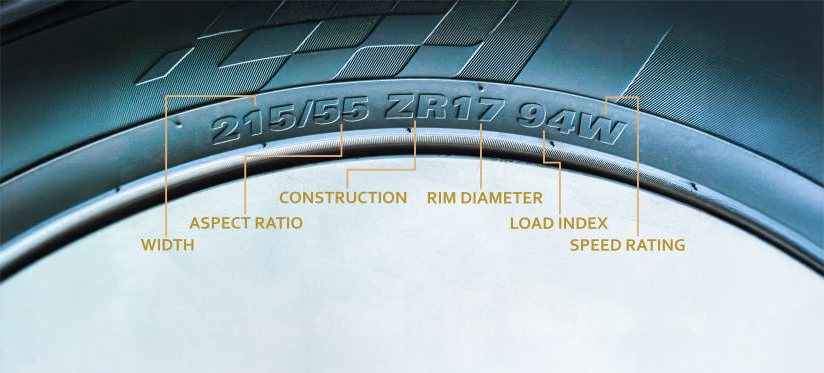
Understanding Tyre Size: The Core Numbers
The most prominent markings on your tyre indicate its size. These numbers dictate the tyre's dimensions and how it will fit your vehicle. Let's break down the "265/70 R16" part of our example tyre.
265: This number represents the tyre's section width in millimetres. In our case, the Apollo Apterra AT2 is 265mm wide from sidewall to sidewall.
70: This is the aspect ratio, expressed as a percentage. It represents the ratio of the tyre's sidewall height to its section width. A 70 aspect ratio means the sidewall height is 70% of the 265mm width, which is 185.5mm.
R: This letter indicates the tyre's construction. "R" stands for radial, the most common type of tyre construction today. Radial tyres have cords that run perpendicular to the tread, providing a smoother ride and better fuel efficiency.
16: This number denotes the wheel diameter in inches. Our example tyre is designed to fit a 16-inch wheel.
Tyre Type and Construction: Beyond the Basics
Beyond the size, other letters indicate the tyre's intended use and construction. Understanding these is vital for choosing a tyre that suits your driving needs.
T: This letter represents the tyre's speed rating. The speed rating indicates the maximum speed a tyre can safely sustain under specified conditions. "T" signifies a maximum speed of 118 mph (190 km/h). Refer to a tyre speed rating chart for a comprehensive list of ratings. Choosing a tyre with a lower speed rating than your vehicle's capabilities can be dangerous.
AT2 (in Apollo Apterra AT2): This alphanumeric code is specific to the tyre model and often indicates its intended use. "AT" generally signifies "All-Terrain," suggesting this tyre is suitable for both on-road and off-road driving. "2" likely refers to a generation or version of this particular All-Terrain model.
Load Index and Maximum Pressure:
Two crucial markings relate to the tyre's load-carrying capacity and inflation pressure. These ensure safe and optimal performance. While not directly part of our example "265/70 R16 T" sequence, you'll find these markings elsewhere on the sidewall.
Load Index: This number represents the maximum weight a tyre can carry at its maximum permissible inflation pressure. You'll find this number on the sidewall, often near the size markings. Consult a load index chart to determine the corresponding weight capacity. Exceeding this limit can damage the tyre and compromise safety.
Maximum Pressure: This indicates the maximum inflation pressure for the tyre when cold. It's usually expressed in PSI (pounds per square inch) or kPa (kilopascal). Never exceed the maximum pressure indicated on the sidewall. Proper inflation is crucial for handling, fuel efficiency, and tyre longevity. Consult your vehicle's owner's manual for the recommended inflation pressure for your specific vehicle and load conditions, as it may differ from the tyre's maximum pressure.
Deciphering the Date Code: Knowing Your Tyre's Age
Knowing the age of your tyres is crucial for safety. Older tyres can deteriorate and become more susceptible to failure. The tyre's manufacturing date is encoded on the sidewall using a four-digit DOT code.
DOT XXXX: The last four digits of the DOT code represent the manufacturing date. For tyres manufactured after 2000, the first two digits indicate the week of manufacture, and the last two digits indicate the year. For example, "2218" means the tyre was manufactured in the 22nd week of 2018. For tyres manufactured before 2000, the code is slightly different, with three digits indicating the week and year.
Other Sidewall Markings: Additional Information
Besides the markings we’ve discussed, you may encounter other symbols and codes on the sidewall:
Tread-wear, Traction, and Temperature Grades (UTQG): These provide a standardised comparison of tyre performance. While helpful, they are not absolute measures of performance.
M+S (Mud and Snow): This marking indicates the tyre is designed for improved traction in mud and snow.
Mountain/Snowflake Symbol: This symbol signifies that the tyre meets specific snow traction performance requirements and is suitable for severe snow conditions.
By understanding these sidewall markings, you'll be equipped to make informed decisions when purchasing new tyres for your car or SUV. Always consult your vehicle’s owner’s manual and a qualified tyre professional for recommendations specific to your vehicle and driving conditions.
If you are looking for new tyres but are unable to figure out the best fit for your car, you can always use the tyre finder on our homepage or find the right tyres through the search bar. Alternatively, you can also get in touch with an Apollo Tyres specialist at 1800 212 7070.

